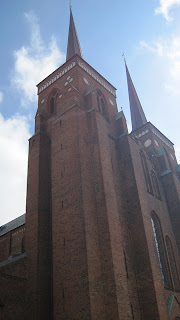During my trip back to Denmark in the Winter of 2012, one of the family trips we took was to Roskilde Cathedral, known in Danish as Roskilde Domkirke. Besides being the first Gothic style cathedral to be built out of brick, and being the dominant figure on Roskilde's skyline, this Cathedral is the final home to the Danish monarchy. One of the first to be buried within this Cathedral was Margrethe I. When she died in 1412 she was actually buried in another location, but her body was moved to Roskilde Cathedral shortly after.
Walking around Roskilde Cathedral is a trip down memory lane for those who know Danish history. For those who do not know the stories behind the great individuals buried here, there is a plethora of information provided, allowing one to learn about the people who shaped the development of Danmark as a nation.
With the paintings adorning the chapels, which were built to house the tombs, and the tombs themselves, one is left with no doubt as to the reason why Roskilde Cathedral was declared a UNESCO World Heritage Site. With the sheer volume of history contained within the cathedral, it is impossible to tell all the stories associated. I shall however tell one of my favorite stories.

Pictured above is the tomb of Margrethe I, one of the most important individuals in Danish history. With the death of Valdemar
‘Atterdag’, King of Danmark, in 1375, his daughter Margrethe I came from Norway to assert her son Oluf's claim to the Danish throne. The 22 year old Margrethe came from Norway as the wife of King Hakon of Norway. Though she claimed the Danish throne on behalf of her son, she was permitted to rule for him due to his age. Five years later, her husband King Hakon died, leaving her to rule both Kingdoms on behalf of her son. Desiring
to expand, Margaret had her son Oluf claim to be the “true heir to Sweden” as
the grandson (through his paternal side) of Magnus Smek of Sweden.
Unfortunately for Margrethe, Oluf dies shortly after this assertion, leaving Margrethe in the predicament of having renounced her right to the Danish throne and having no right to the throne of either Norway or Sweden. Despite this lack of formal claim, the nobility in Danmark and Norway allowed Margrethe to remain in control, referring to her as "Dame of our Kingdoms, Master of our House, Mighty Guardian." In order to gain control of Sweden, after an attempt at negotiations, there was a battle fought at Falkoebing. After a Swedish defeat and a term of imprisonment for Albrecht, the Swedish King, the outcome was decided. Albrecht relinquished the Kingdom of Sweden putting it under the power of Margrethe. In order to secure familial succession of these Kingdoms, she adopted her sister's grandson, renaming him Eric. Eric of Pomerania, as he came to be known, was crowned King of Scandinavia at the Kalmar Convention in 1397.
The Kalmar union between Danmark,
Sweden, and Norway lasted until 1523, with the separation of the Swedish
kingdom. Between Norway and Danmark this union lasted from 1380, when Margaret
acquired control of Norway, until 1814. As such, the Kalmar Union was a
significant development, not just for the history of Danmark but for the history of the region
One of my favorite areas in the Cathedral is the Chapel of Christian IV. The paintings in this room are utterly magnificent, and appear from a distance to be sculptures. You can see this in the picture above. The pillars on the wall are not actual pillars but a portion of the painting. Knowing the rest of the monuments in Danmark that Christian IV was involved in, it is not surprising that this room has paintings of such splendor.











